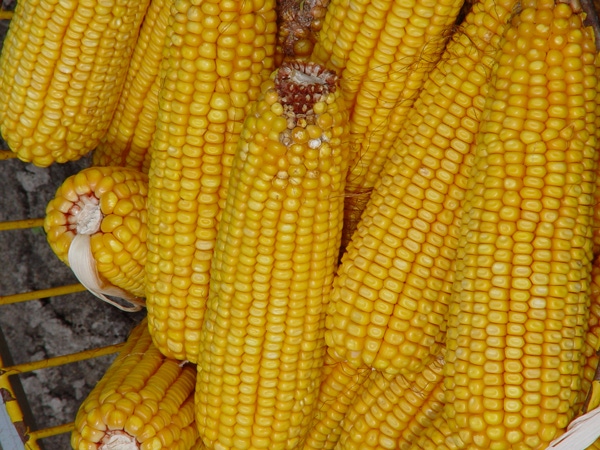
Corn prices — don't look a gift horse in the mouth
It's decision-making time for those marketing corn, grain analyst Richard Brock says. Look for a combination of crop insurance, hedge-to-arrive contracts and call and put options.Rapidly improving corn genetics have kept corn yield respectable through several years of unfavorable weather. If there is ever a year when everything goes right, yields could respond in a big way.The Midwest is setting up for a good year if the weather cooperates. The region has ample soil moisture and fertilizer applications have been made.

There are three factors to watch in the corn market over the next five months, said grain analyst Richard Brock — planted acreage, corn yield potential and feed and residual use.
Brock, addressing producers at the Mid-South Farm and Gin Show in February, believes that the latter should be decreasing in the next few months because USDA is projecting more corn being crushed for ethanol, therefore allowing for more substitution of DDGs, which would reduce the feed and residual number. Feed and residual use for 2010-11 is currently estimated at 5.2 billion bushels, but Brock said it could be as low as 4.9 billion bushels. “That would be a reduction of 300 million bushels added to the carryover.”
Brock estimates that corn ending stocks will increase from 675 million bushels in 2010-11 to 979 million bushels in 2011-12. “That’s still reasonably tight, but if you add 300 million bushels from feed and residual, that takes you to 1.279 billion bushels.”
Brock believes corn acreage will fall between 91 million and 92 million acres this season. He pegs corn yield at 166 bushels, a number which might be too low, especially if favorable growing conditions allow corn genetics to reach their full potential.
Brock believes that rapidly improving genetics have kept corn yields respectable through several years of unfavorable weather. But if there’s ever a year when everything goes right, yields could respond in a big way.
The Midwest is setting up nicely for such a year, he says. “I have never seen better soil moisture and conditions in prior to spring planting. In 2009, we had the worst fall we ever had. It was wet and it was long. Farmers were still harvesting corn in January. There were cartoons going around of a combine running through the field with the corn planter right behind it.”
That was followed in 2010 by the earliest harvest in history. That led to timely ground preparation for this season’s crop. “We had the heaviest fall fertilizer application we’ve ever seen. Now the big question is how big is the opening for planting going to be this spring.”
If it all comes together, yield pushing 172 bushels per acre “is not out of the realm of possibility,” Brock said. “Obviously, you can’t count on that until you get the crop planted, but if you get this crop planted and get to the middle of June without any major crop problems or heat issues, we could really ramp these yields up.
“If U.S. growers plant 92 million acres of corn and produce a yield of 172 bushels per acre, carryover jumps to 1.6 billion, and you’re looking at a corn crop that’s $2 a bushel overpriced.
“The bulls will argue that we have a tight stocks-to-use ratio and if we have any delays getting planted or weather problems in May and June, we could blow the top off the market. But I think that’s a tough bet. I can build a fundamental argument for bearish scenarios in corn, cotton and soybeans. All it takes is one good crop. But we have to get them planted.”
Time to make decisions
It’s decision-making time for marketers, Brock says. “The time is right now. Markets are anticipatory. They’re based on what’s about to happen, not what already has. Once the crop gets in the ground, opportunities are going to be gone.”
To lock in corn prices, Brock says to look at a combination of crop insurance, hedge-to-arrive contracts and call and put options.
“Crop revenue insurance should fly off the shelves,” according to Brock. “Your price for corn is determined by the average of December futures during February. Because of the bull spread market, we’re probably going to average $5.93. If you buy a 70 percent policy, it’s going to be expensive. But you’ll have a floor under your crop at that price. Then I’m going to either a hedge-to-arrive contract or hedge it myself on the other 30 percent. You can put a floor under 100 percent of your crop and you still have the upside left.”
Brock says buying out-of-the-money calls only “is probably not going to work. If you want to protect yourself on the upside, you have to buy calls and sell some out-of-the money puts to help you finance it. The premiums are just too high to buy calls or puts. Eighty percent of the time, you’re going to lose whatever you pay for them anyway.”
Grain storage may not be a good option this year, Brock adds. “The market is telling producers that it doesn’t pay to store corn this year. In order for grain storage to work, you have to have a carrying charge market. Storage is not going to pay. Just because you have a bin doesn’t mean you have to use it.”
Brocks advised producers to “get everything sold for late August and early September delivery, take advantage of this premium, then rent the bins to your neighbor who didn’t figure it out.
“Southern farmers have a huge advantage over Midwest farmers. You have a premium market because your crop comes off early. Don’t look this gift horse in the mouth and not take advantage of it. It’s an incredible opportunity.”
About the Author(s)
You May Also Like





